A 'Bot in the OceanAn Automated Instrument Platform Gathers Data as it Cruises the Southern OceanPosted December 14, 2020
During the past austral summer, scientists released an autonomous seafaring robot into the Southern Ocean. 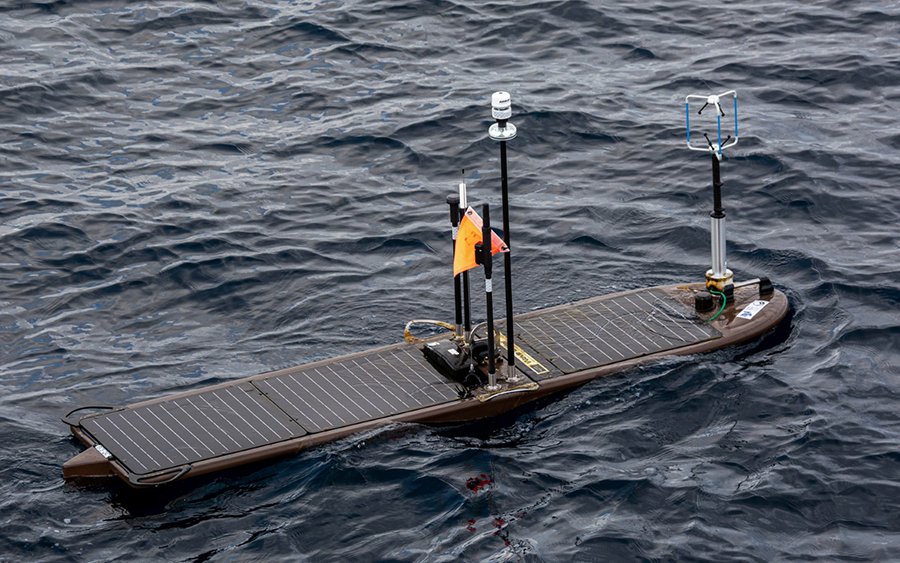
Photo Credit: Mike Lucibella
The Wave Glider ASV floats in the waters of the Southern Ocean. Its solar panels power its onboard science instruments that measure the surrounding ocean and atmosphere.
For four months, the small "Wave Glider" navigated the frigid Antarctic waters, collecting data on the surrounding ocean and atmosphere. At the end of the season, it was plucked from the sea and returned home so researchers could use what it learned to better understand how the Southern Ocean affects the planet's climate. "It's a way to improve our observations of air-sea interactions in a climate-critical part of the world," said James Girton, a physical oceanographer at the University of Washington and principal investigator on the project. "The Antarctic circumpolar current, and especially the area between the current and the Antarctic continent, are kind of a critical region for the global climate." It's the second run for the glider, and the team is working to further develop the technology so more might someday be deployed for long-term monitoring of one of the hardest to reach oceans in the world. "Our project is focused a lot on technology development—getting a more robust platform to be able to make air-sea interaction measurements in the Southern Ocean," Girton said. "We're working with this wave glider as a way to build experience with autonomous platforms." The research is supported by the National Science Foundation, which manages the U.S. Antarctic Program. Robot SurfboardThe glider is what's known as an "autonomous surface vehicle," or an ASV. Powered by the sun and propelled by the waves, the instrument is designed to operate on its own for months at a time. At the beginning of the austral summer, researchers lowered it into the ocean then didn't need to touch it until it was pulled out again at the end of the season. 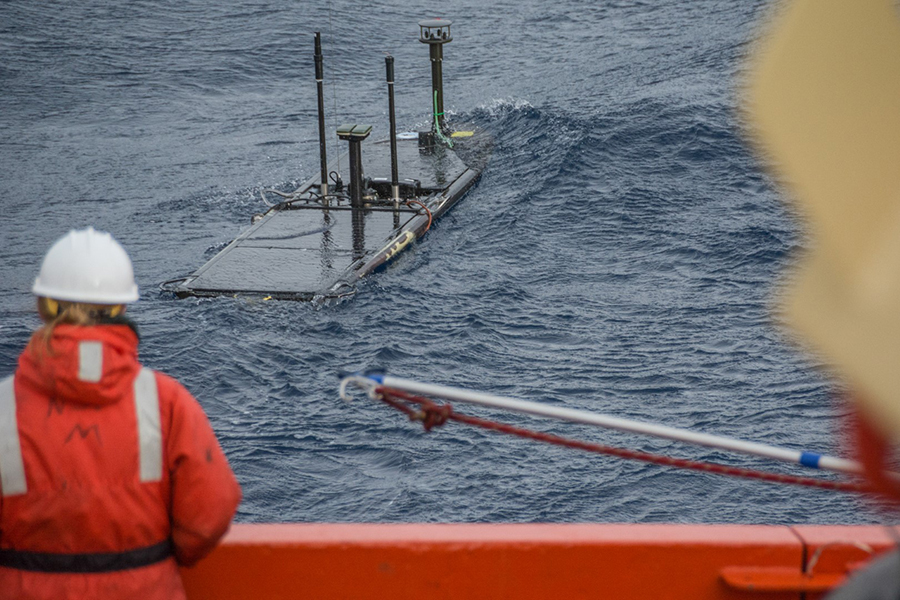
Photo Credit: Mike Lucibella
Marine technician Amy Belcher prepares to pull the Wave Glider ASV on board the research vessel Laurence M. Gould.
"It looks like a surfboard," said Ryan Newell, a field engineer at the University of Washington. "It has a few solar panels on top and a few masts for wind speed and satellite and stuff." The solar panels power the glider's instruments and its rudder, but not its propulsion. Instead, the vehicle harnesses the natural up and down motion of ocean waves to pull itself across the surface of the water. "There's what we call a sub-unit that sits about eight meters below the surface and it has a bunch of wings on it," Newell said. "It's pulling on the surface vehicle. As the surface vehicle gets yanked up and down in the waves, the wings on that articulate and propel it forwards." These articulating wings look like a cross between vanes on a television antenna and the slats of venetian blinds. Developed by the company Liquid Robotics, the sub-unit's vanes rotate up and down in order to capture the energy of the ocean waves. "It's a pretty ingenious mechanism that they came up with, and it works quite well," Girton said. "Basically, the vanes tilt upwards when the device is being pulled up, and they tilt down when the device is dropping down through the water. In each of those cases, that's providing a forward thrust." It's an efficient system. The glider never needs any electrical power to move and can keep going almost indefinitely. "It never truly stops moving, it's always getting pushed a little bit and on that sub-unit there's a rudder that we can use to steer it," Newell said. "It's a funny vehicle in that you can put it in the ocean and it will start going directly into the waves." Over a full summer, the vehicle can traverse hundreds or potentially thousands of miles across the ocean, but not quickly. 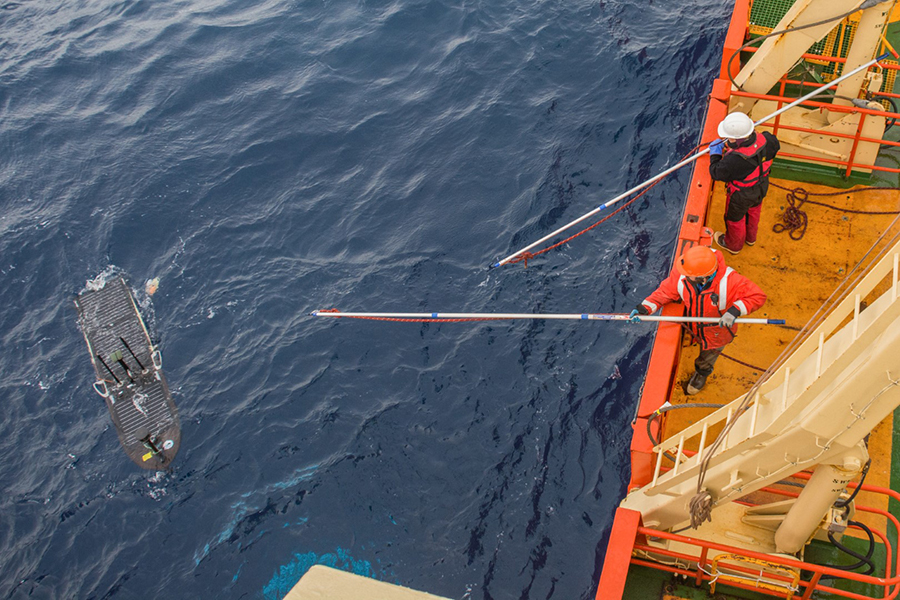
Photo Credit: Mike Lucibella
Marine technicians Amy Belcher (top) and Matt Lewis work to grab the Wave Glider ASV and pull it on board the research vessel Laurence M. Gould.
"It travels somewhere between one and two knots. So, it's not going particularly fast but it can make headway almost all the time," Newell said. Listening to the OceanWhile cruising the oceans, the glider is constantly collecting a wide range of data from its instruments. It carries with it two acoustic Doppler current profilers, devices that use sound waves to measure ocean currents throughout the water column. "Together they should give us a profile of the current down to about 100 meters below the surface," Girton said. "There are multiple wind measurements as well." On two of the masts sticking up on top of the surface "surfboard" are sonic anemometers, devices that similarly use sound waves to measure wind speed and direction. One of them measures wind in three dimensions, giving the team a way to measure the turbulence of the wind in addition to just its speed and direction. Also on board are instruments to record the strength of the waves. One of the devices use GPS measurements while the other uses an accelerometer to complement each other's data. This year the team added a winch that could raise and lower an apparatus to profile the ocean down to about 150 meters. It's a conductivity, temperature and depth profiler, a standard tool used by oceanographers to measure the temperature and salinity of the ocean throughout the water column. Unfortunately, after only about ten uses, the device apparently broke. 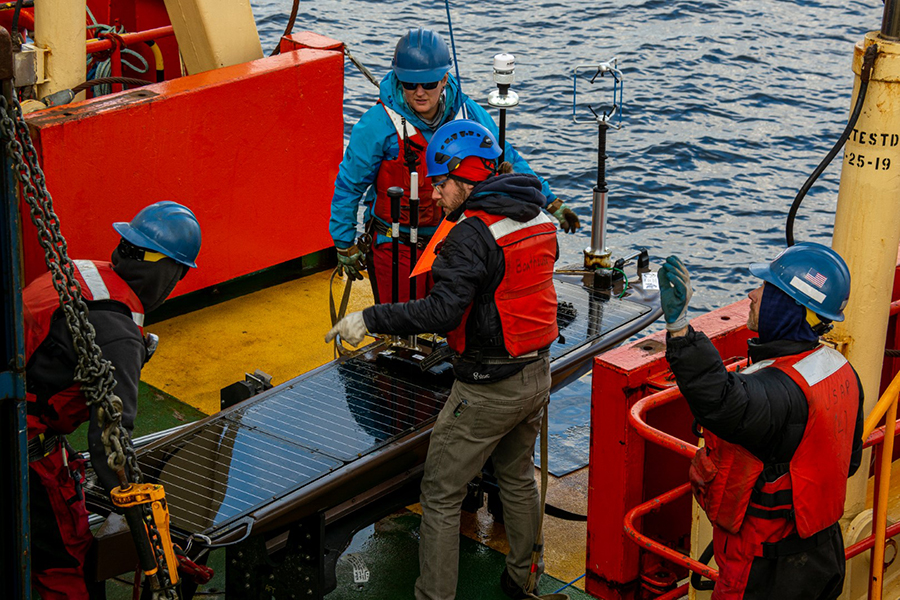
Photo Credit: Mike Lucibella
After hoisting the Wave Glider ASV up to the deck, Ryan Newell (center) and marine technicians on board the research vessel Laurence M. Gould work to secure it and pack it for transport back home.
"It did work initially, but it didn't last for very long," Girton said. "There's a long history of people trying to make autonomous winches and it's hard to make them last for very long." The team is continuing to develop a more robust winch that can last the full deployment. It's an important tool for characterizing a region of the ocean that's difficult to observe remotely. "One of the pieces that you miss from a satellite looking at the ocean is what's happening below the surface," Girton said. "The upper ocean stratification is a key missing observed quantity that we know we want to get." Observations into PredictionsOceans and the atmosphere interact with each other in complex ways, creating hard to predict short-term weather patterns and long-term climate trends. "The main reasons you want to collect this data is to get a better idea of what the ocean and the atmosphere are doing down here and how they interact with each other," Newell said. The Southern Ocean surrounding Antarctica and its circumpolar current wields significant influence on climate around the world. It absorbs a great deal of heat and carbon dioxide out of the atmosphere, connects the world's oceans together and drives many of the major ocean currents that distribute heat throughout the planet. A change or disruption in any of these processes would have impacts far beyond Antarctica. 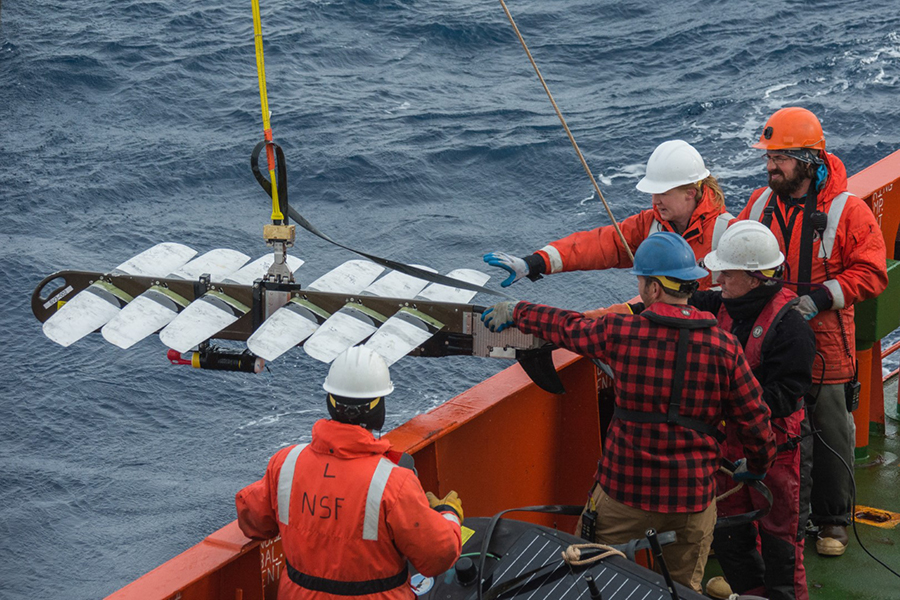
Photo Credit: Mike Lucibella
(Left to right) Marine technicians Sean Bercaw, Dave Moore, Amy Belcher, Chuck Holloway and Matt Lewis work together to pull aboard the Wave Glider ASV's propulsion sub-unit. The articulated vanes harness the motion of ocean waves to drive the autonomous vehicle.
"A lot of the big questions on how much heat is getting into the ocean from the atmosphere and how much carbon dioxide is getting in, are centered around Antarctica," Girton said. Despite its importance, there are a lot of open questions about how the heat transfer, the gas interchange and how the currents all interact with each other. Its remoteness and stormy seas make the Southern Ocean difficult to study. Few ships sail through its waters, and those that do often stick to established areas, leaving vast regions with little or no data. The autonomous glider has more freedom to explore remote regions without the need of an entire research vessel and crew. "You can run it for months at a time without having a ship there," Newell said. "It's quite challenging to collect this data down here and it's very expensive to use ship-based platforms." By staying in the ocean for months, a wave glider can gather a great deal of data about the ocean's characteristics. The data it takes helps tell researchers how much heat energy, moisture, and gasses pass between the atmosphere and the oceans. "The issues really come down to how quickly do you transfer heat and momentum and gasses between the air and the ocean at any given point in the world's ocean. Those are called air-sea fluxes," Girton said. Researchers around the world are working to develop accurate computer models of the oceans that can calculate and predict the future of the planet's oceans as the climate warms. Oceans are complex, and subtle differences over long periods of time can lead to big differences between predictions and reality. The more data researchers can input into their models at the outset, the better and more accurate their final predictions will be. 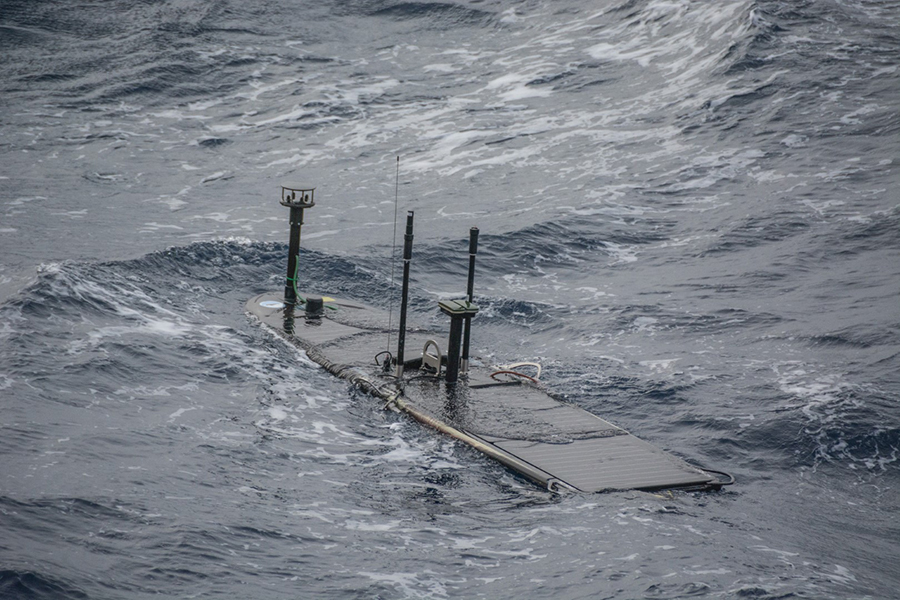
Photo Credit: Mike Lucibella
Between its solar powered instruments, and wave-powered propulsion, the Wave Glider ASV can navigate the ocean and collect data for months at a time.
"You measure the surface air temperature and the surface water temperature and you take those together and you get a heat flux from them but maybe you also need to know the wind speed and you need to know the wave properties," Girton said. To make better predictions, researchers use a technique called "parametrization" to distill all the complex aspects of a physical process into a simplified model that calculates outcomes more easily than if it were to compute each contributing facet separately. Ultimately researchers hope to model the Southern Ocean so well that with only a limited number of input parameters, they can calculate the long term conditions of the climate, including the response of the oceans to wind and temperature changes and the impact in turn from the ocean back onto the atmosphere. "We're not going to be able to cover the whole Southern Ocean with this one wave glider," Girton said. "We might be able to use the measurements we get to develop better parametrizations that would allow satellite measurements that do cover the whole globe to be better able to be converted into air-sea flux estimates." Now that the glider is back on dry land, the team is working on processing the data they collected from its deployment over the last austral summer, and further improving its instruments for future seasons. NSF-funded research in this story: James Girton, University of Washington, Award No. 1853291. |



For USAP Participants |
For The Public |
For Researchers and EducatorsContact UsU.S. National Science FoundationOffice of Polar Programs Geosciences Directorate 2415 Eisenhower Avenue, Suite W7100 Alexandria, VA 22314 Sign up for the NSF Office of Polar Programs newsletter and events. Feedback Form |


